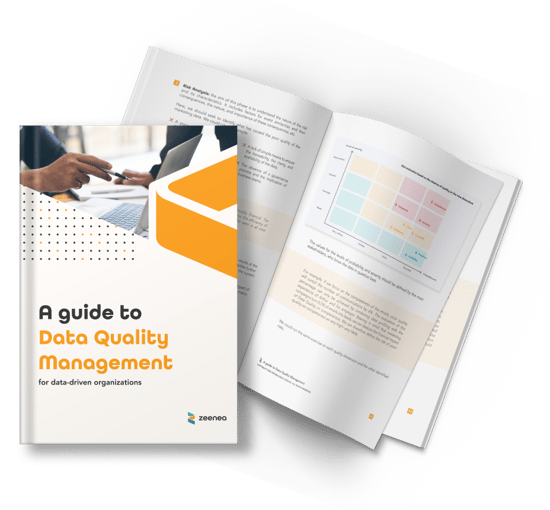A guide to Data Quality Management
for data-driven organizations
Nicolas Boisnic - Product Manager - Zeenea
"I wrote this eBook as a guide to answer all your questions about the discipline of Data Quality Management (DQM). Happy reading."
🔸 What is Data Quality?
🔸 What are the challenges of DQM?
🔸 What are the key features of DQM tools on the market?
🔸 How can a Data Catalog contribute to DQM?

Overview
Data Quality usually refers to a company’s ability to ensure the longevity of its data. At Zeenea (a data catalog provider), we believe Data Quality is ensured through the 9 following dimensions - all essential to extract value to your company:
🔸 Completeness
🔸 Accuracy
🔸 Validity
🔸 Uniqueness
🔸 Consistency
🔸 Timeliness
🔸 Traceability
🔸 Clarity
🔸 Availability
We will detail these dimensions with the help of a simple example in part one. We will then elaborate on how Data Quality management is an important challenge for organizations seeking to extract maximum value from their data.
We will also draw parallels between these different Data Quality dimensions and the different risk management phases to overcome - identification, analysis, evaluation, and processing. This will enable you to hone your risk management reflexes by tying in Data Quality improvement processing to a company objective (and evaluating the ROI on each quality dimension).
Once we have established the main features of an enterprise Data Quality management tool, we will detail how a Data Catalog - though not a Data Quality tool - can contribute towards Data Quality improvement (through the clarity, availability, and traceability dimensions mentioned above).
Overview
Data Quality usually refers to a company’s ability to ensure the longevity of its data. At Zeenea (a data catalog provider), we believe Data Quality is ensured through the 9 following dimensions - all essential to extract value to your company:
🔸 Completeness
🔸 Accuracy
🔸 Validity
🔸 Uniqueness
🔸 Consistency
🔸 Timeliness
🔸 Traceability
🔸 Clarity
🔸 Availability
We will detail these dimensions with the help of a simple example in part one. We will then elaborate on how Data Quality management is an important challenge for organizations seeking to extract maximum value from their data.
We will also draw parallels between these different Data Quality dimensions and the different risk management phases to overcome - identification, analysis, evaluation, and processing. This will enable you to hone your risk management reflexes by tying in Data Quality improvement processing to a company objective (and evaluating the ROI on each quality dimension).
Once we have established the main features of an enterprise Data Quality management tool, we will detail how a Data Catalog - though not a Data Quality tool - can contribute towards Data Quality improvement (through the clarity, availability, and traceability dimensions mentioned above).















